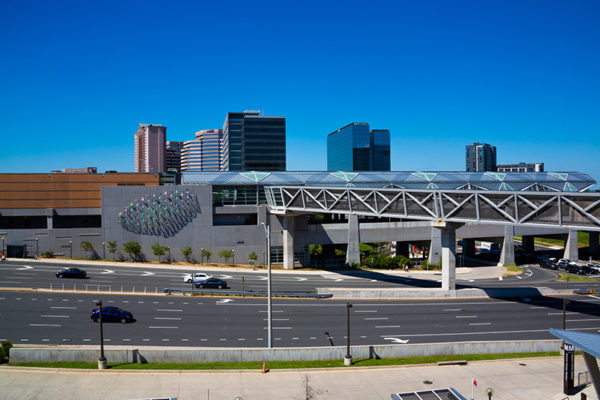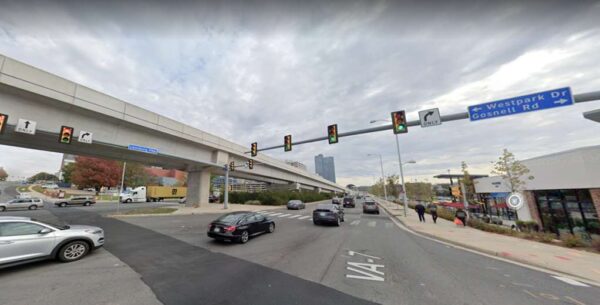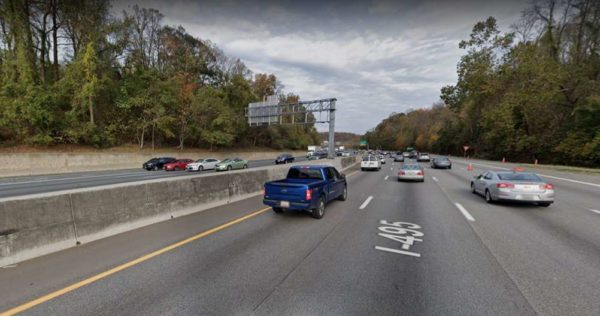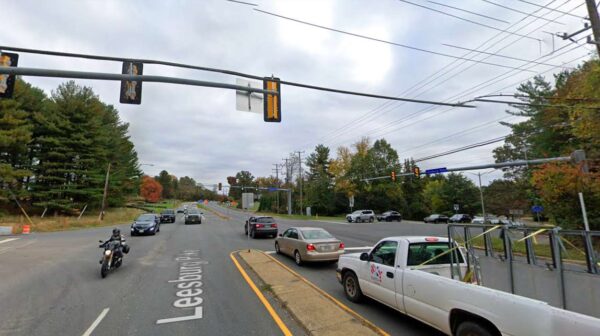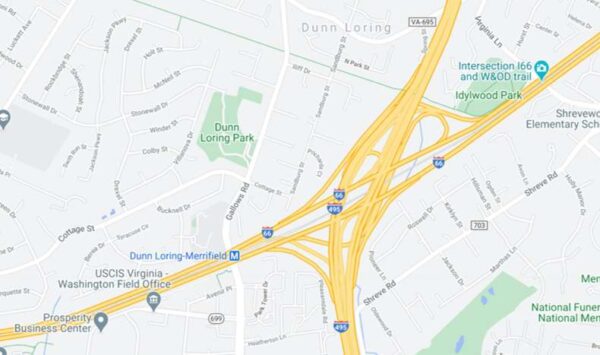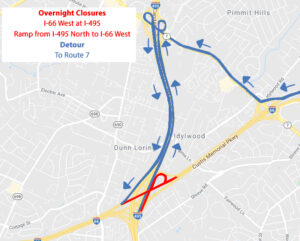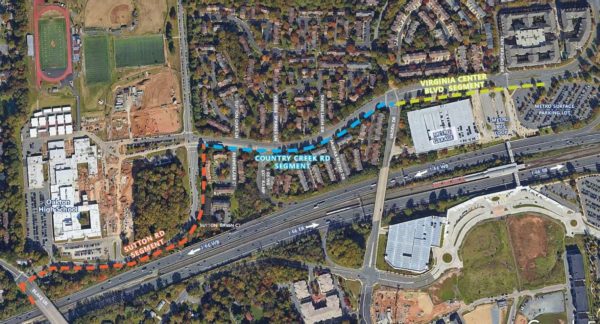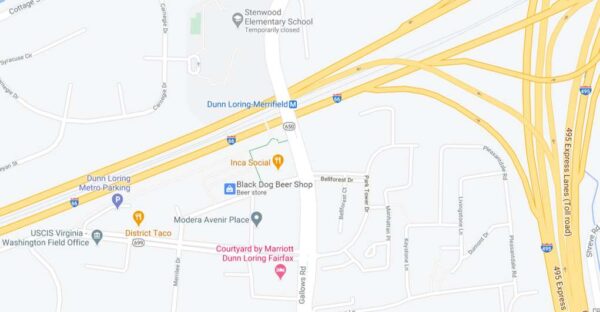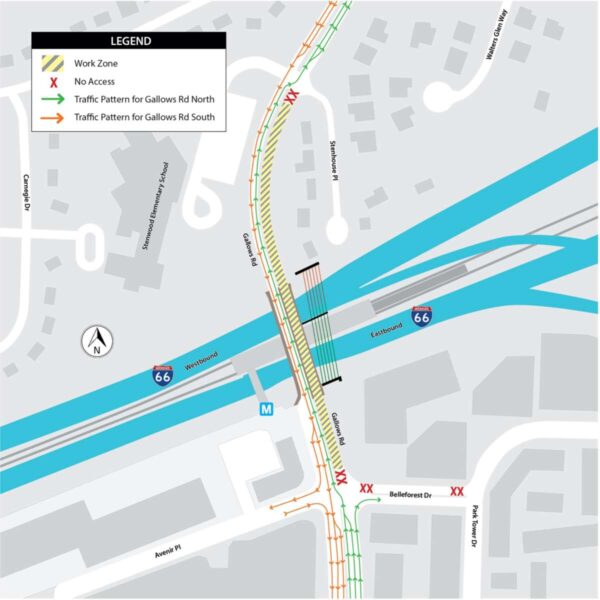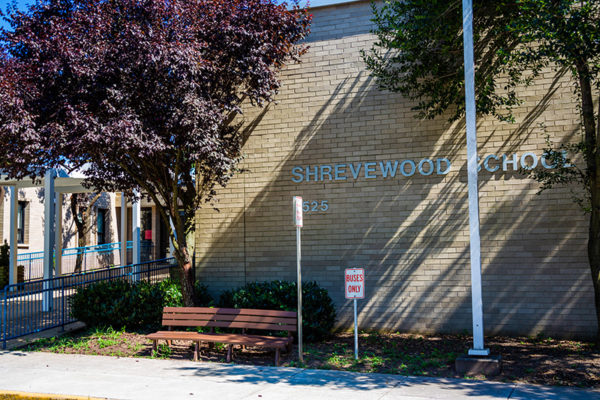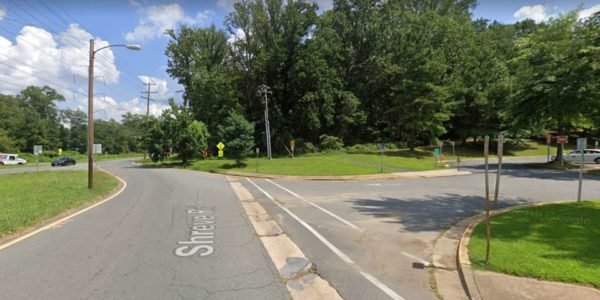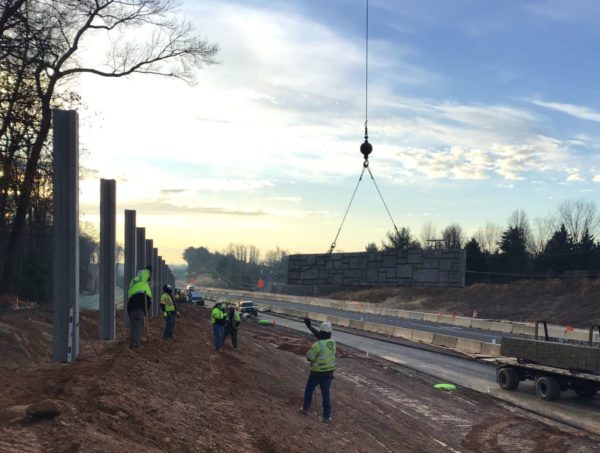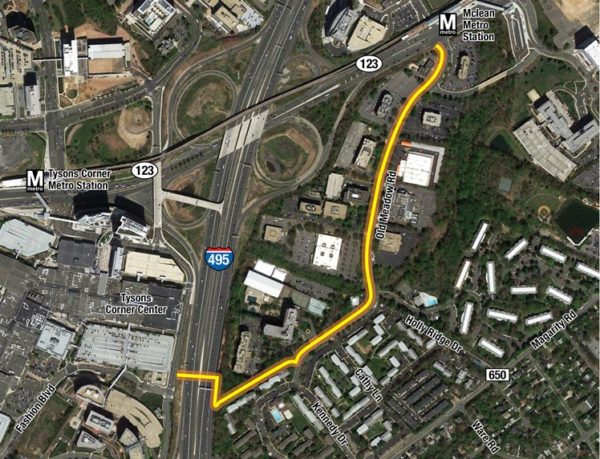
The Virginia Department of Transportation has selected Shirley Contracting Company to build a bridge and shared-use path along Old Meadow Road, providing a crucial connection from Tysons Corner Center to the McLean Metro station over I-495.
The contract was awarded in June but has not been finalized yet. VDOT project manager Abraham Lerner confirmed that construction is still expected to start this summer.
“At this time we do not have a specific date when the construction of the Tysons Old-Meadow Road project is expected to begin,” Lerner told Tysons Reporter by email. “We need to finalize the administrative processes related to getting the contractor under contract…We will reach out to the community prior to starting construction work.”
Based in Lorton, Shirley Contracting is an affiliate of Clark Construction, which has been involved in numerous other projects in Fairfax County, including the second phase of Metro’s Silver Line project.
The project will provide a bridge over the Capital Beltway for pedestrians and bicyclists, who currently have no easy way to cross the interstate at the Route 123 interchange. It will also involve the addition of a 4,662-foot-long, 10-foot-wide trail along the west side of Old Meadow Road.
Construction will unfold in two phases due to the availability of funding, according to Lerner.
The first phase will introduce the bridge and a portion of the shared-use path up to the Provincial Drive intersection. Construction will be supported by $8.5 million in funding and is expected to be complete in the summer of 2022.
The shared-use path will then be extended to Route 123 during the project’s second phase, which will begin construction once “additional funding becomes available,” VDOT says.
Getting to and from Metro stations can be a harrowing experience for pedestrians and cyclists, and the Fairfax County Planning Commission and others want something to be done about it.
The planning commissioners have called on the Fairfax County Board of Supervisors to require Metro, the state and county transportation departments, and more to “work immediately” to make safety and accessibility improvements for pedestrians and bicyclists to transit stations.
“This is a call for action by the public to improve pedestrian/bicycle access to metro stations as envisioned in the comprehensive plan,” Hunter Mill District Planning Commissioner John Carter said when introducing a motion during the commission’s meeting on May 19.
The measure calls for numerous changes, such as:
- Providing wide sidewalks at intersections within walking distance of transit stations,
- Making turns on roads tighter at intersections to slow traffic down,
- Providing a “double ramp” for people with disabilities instead of single ramp that’s currently in use directing pedestrians to the middle of intersections,
- Avoiding extra turning lanes at intersections with high volumes of pedestrians
- Providing closely spaced street trees between curb and sidewalk areas to protect pedestrians.
The motion passed, with 10 members voting for it and at-large member Timothy Sargeant, abstaining. Sargeant did not respond to a message seeking comment on why he voted that way.
“Failure to act will cause pedestrian access to continue to be ‘significantly challenged’ and ridership on the metro station to be reduced,” Carter said.
He introduced the motion during the commission’s discussion on whether to approve changes to the mixed-use Reston Gateway development being constructed near the upcoming Reston Town Center Metro station, but he noted that the issues seen there could apply to other locations as well.
Supervisor Walter Alcorn, whose Hunter Mill District includes the Reston Gateway project, agrees that the main crosswalk serving the Reston Town Center station is not pedestrian-friendly.
“The rail project used cookie-cutter designs,” he said, adding that a walkway over the road has been proposed but could be years away from coming to fruition.
When touring the area a couple weeks ago, Alcorn asked the Fairfax County Department of Transportation to identify short-term improvements to occur before the station opens, which isn’t expected to happen until early 2022.
“I want to make sure riders can readily get to the stations on day one and every day thereafter,” he said.
Pedestrian and bicyclist advocacy groups expressed support for the commission’s call for change.
Fairfax Alliance for Better Bicycling President Bruce Wright says some progress has been made to improve safety, but numerous deficiencies remain. The Greensboro station in Tysons, for example, not only lacks access from Gosnell Road and Westpark Drive, the roads are outright dangerous, he says.
Updated at 4:10 p.m. on 5/21/2021 — The Commonwealth Transportation Board unanimously approved the resolution to designate the 495 NEXT lanes as high-occupancy toll lanes during its meeting on Wednesday (May 19).
Earlier: Plans to extend the I-495 Express Lanes from the Dulles Toll Road to the American Legion Bridge are about to inch a little closer to a reality.
The Commonwealth Transportation Board’s meeting agenda for today (Wednesday) includes a vote on whether to designate the Virginia Department of Transportation’s I-495 Express Lanes Northern Extension (495 NEXT) project as high-occupancy toll lanes.
The move would pave the way for 495 Express Lanes operator Transurban to expand its operations into McLean past George Washington Memorial Parkway, if VDOT’s plans to widen the interstate with two dedicated travel lanes in each direction materialize.
VDOT’s Northern Virginia Megaprojects Office, which is handling the 495 NEXT project, told Tysons Reporter that it expects the Federal Highway Administration to issue a decision on the Environmental Assessment by the end of May 2021.
“A final project agreement between VDOT and Transurban, or commercial close, is expected in August 2021, followed by the project’s financial close in December 2021,” VDOT said.
In addition to formally designating the proposed lanes as HOT lanes, the CTB vote will establish a high-occupancy requirement of three or more individuals and authorize Virginia Commissioner of Highways Stephen Birch to develop a new memorandum of understanding with the Federal Highway Administration to govern the extended lanes.
According to the resolution, if approved, the HOT lane designation will officially take effect once a “Service Commencement Notice to Proceed” is issued, meaning the lanes are opened for public use, which VDOT now says it doesn’t anticipate happening until 2025.
VDOT is asking the CTB to approve the resolution in anticipation of amending an agreement that it originally signed on Dec. 19, 2007 with Transurban, which has operated the existing 14 miles of 495 Express Lanes since they opened in 2012.
Like its MOU with the FHWA, VDOT’s agreement with Transurban needs to be revised to include the two miles of lanes that would be added with the 495 NEXT project.
As with the existing express lanes, the tolls for the new lanes will likely be determined using congestion pricing, which fluctuates based on the number of vehicles on the road at a particular time, according to the resolution.
The 495 NEXT project has been in the works since late 2019, when Virginia Gov. Ralph Northam and his Maryland counterpart, Larry Hogan, announced an accord to replace the American Legion Bridge and widen the Capital Beltway to relieve traffic congestion.
The project has been endorsed by local chambers of commerce and, more recently, the Fairfax County Board of Supervisors, but many community members and officials — including members of the county board — have expressed concerns about the potential environmental impact and the prospect of Maryland failing to follow through on its half of the Beltway accord.
The Maryland Department of Transportation decided last week to shrink the scope of its I-495/I-270 HOT lanes project, opting to focus on the western section that includes the American Legion Bridge.
Officials said the move will allow the project to move forward more quickly, since it cuts out a large portion of the design that drew strong opposition from residents and local leaders in Montgomery County.
In a statement to Tysons Reporter, the VDOT Northern Virginia Megaprojects Office says it will continue to work with Maryland “to coordinate our two projects”:
Maryland’s announcement regarding the state’s modified approach for their environmental document indicates Maryland’s continued focus on the American Legion Memorial Bridge (ALMB) and the I-495 segment between the ALMB and the I-270 Spur. The new recommended preferred alternative (RPA) by Maryland and FHWA, known as Alternative 9, Phase 1A South, includes the same two HOT managed lanes in each direction on I-495 that were in Maryland’s previous RPA, and is compatible with Virginia’s 495 NEXT project.
Photo via Google Maps
(Updated at 10:10 a.m. on 4/13/2021) The Fairfax County Board of Supervisors will take an official position on the Virginia Department of Transportation’s much-debated Interstate 495 Express Lanes Northern Extension (495 NEXT) project when it meets on Tuesday (April 13).
A prepared letter to Virginia Secretary of Transportation Shannon Valentine suggests the board plans to endorse the project, which will extend the I-495 Express Lanes about three miles from the Dulles Toll Road interchange in Tysons to the American Legion Memorial Bridge.
However, whether the board will actually approve the letter as it currently stands remains to be seen.
Dranesville District Supervisor John Foust told Tysons Reporter on Friday (April 9) that he hopes to revise the letter with firmer language calling for closer coordination with Maryland’s plans to widen the American Legion Bridge and I-270 and objecting to the design of the Capital Beltway/Dulles Toll Road interchange.
“If I can’t get those revisions made, I won’t be able to support it,” Foust said.
The letter says the 495 NEXT “will improve mobility” in the D.C. region by connecting the existing 495 Express Lanes to toll lanes that Maryland is considering constructing on its side of the Potomac River.
It indicates that Fairfax County and VDOT have made progress on addressing transit, pedestrian and bicycle facilities, and stormwater management concerns that have been raised throughout the project’s development.
According to the letter, VDOT will fund the capital and operating costs of one of the Tysons-Montgomery County bus routes proposed by the Virginia Department of Rail and Public Transportation’s transit demand management study.
The state has also now committed to continuing its planned regional trail toward Tysons instead of stopping it at Lewinsville Road, and the county is working with VDOT to secure an agreement that would require the 495 NEXT builder to contribute funds to Scotts Run stream restoration efforts.
At the same time, county officials say they “remain concerned” about the possibility that Maryland will further delay its express lanes project. Without a widened American Legion Bridge, the 495 NEXT project would simply move the congestion that currently plagues drivers on the Beltway further north.
“The continuation of an express lanes system into Maryland over the ALMB remains a critical priority to realize the maximum benefit of the I-495 NEXT project,” the Board of Supervisors letter says. “The Board continues to strongly encourage VDOT to coordinate with Maryland to minimize the time between the opening of the I-495 NEXT express lanes and Maryland’s managed lanes.”
Foust says he hopes to revise the letter to tell the Commonwealth Transportation Board “to wait until we are certain that Maryland is going to move forward with their project before we authorize [express lanes operator] Transurban to begin construction of 495 NEXT.”
He also wants to make clear his opposition to the proposed design of the Dulles Toll Road interchange.
“I suspect that it is designed to move cars very effectively, but it is just outrageously huge and visually unacceptable for that location adjacent to Tysons,” he said.
Virginia and Maryland’s Beltway plans have also drawn criticism from environmental advocates.
The Coalition for Smarter Growth, Audubon Society, National Parks Conservation Association, and Sierra Club chapters from both states released a “Best Smart Growth Plan” on Friday, urging officials to pause the projects and conduct a comprehensive analysis to find “a less destructive and more sustainable and equitable solution.”
Foust says he is “sensitive” to the groups’ environmental concerns, noting that some impact on parks, trees, streams, and open space is unavoidable with an infrastructure project of this size.
However, he believes Virginia and Maryland have already waited too long to address the traffic issues at the American Legion Bridge, and postponing action for another 15 years, when the bridge is expected to need a replacement, would be “absolutely unacceptable.”
“We’ll have to mitigate those impacts, but there’s no reason to incur them if Maryland doesn’t move forward with their project to connect to 495,” Foust said.
VDOT acknowledged that there have been persistent concerns about 495 NEXT in a statement to Tysons Reporter:
VDOT continues to
collaborate with the Fairfax County Board of Supervisors and staff to listen to and address their concerns on VDOT’s I-495 Northern Extension Express Lanes Project. The issues identified by Fairfax County remain important to VDOT and to our efforts to develop and deliver the best possible multimodal transportation solution for the I-495 corridor, and make a positive impact on our Commonwealth.
Photo via Google Maps
The Virginia Department of Transportation is moving forward with plans to overhaul the intersection of Towlston Road and Leesburg Pike (Route 7), but despite requests from local residents, the highway’s speed limit will not be reduced after construction is finished.
VDOT officials say the need to move traffic to and from Tysons will keep the speed limit on Route 7 at 55 miles per hour.
VDOT discussed the changes coming to the Route 7 and Towlston intersection at a virtual town hall hosted by the Great Falls Citizens Association on March 31.
The need for improvements to the intersection emerged in the aftermath of a fatal crash in December. At the meeting, officials said the incident occurred when a vehicle traveling southbound on Towlston Road attempted a left turn onto Leesburg Pike. A distracted driver ran through the red light and struck the turning vehicle.
“What the community is seeking is an assurance that the intersection will be as safe as possible when VDOT completes its work under the widening project,” GFCA executive board director Mike Barclay said.
Barclay said that the intersection improvements need to ensure that, when a car turns left on Route 7 from Towlston, the driver “will have an unimpeded view of traffic traveling west on Route 7.”
Public feedback at the meeting ranged from urges to reduce the speed limit to a call to convert the intersection into a four-way stop.
Some of those concerns, particularly regarding sight-lines, should be waylaid by the current project to widen Route 7 from Reston to Tysons, VDOT said.
As part of the project, extended turn lanes will be added to Leesburg Pike to make it easier for trucks to turn onto Towlston Road, a response to the common complaint that trucks turning at the intersection often block several lanes of traffic.
Steve Kuntz, transportation business unit manager for consultant Dewberry, said sight-lines at the intersection will be improved as part of ongoing work at the intersection.
“We’re still not in the final configuration,” Kuntz said. “It is still a work in progress. We want to make sure everyone recognizes: what you see today is not the permanent configuration.”
But VDOT said there are no plans to reduce the speed limit on Leesburg Pike.
“Reducing speed on Route 7 is not an option,” VDOT district construction engineer Bill Cutler said. “It’s a highway to Tysons and needs to be able to move people along.”
However, changes will be made to Towlston Road, which will be reduced to 25 miles per hour near the intersection.
Cutler said VDOT will also be working with the contractor and the operations center to optimize timing at the signal as part of a broader effort to synchronize signals throughout the Route 7 corridor.
“We expect that this will function well,” Cutler said. “Now, it won’t function perfectly because we’re in Northern Virginia. Nothing functions perfectly, but it should function better than it has in the past. We’ll take counts and see how that holds up compared to our forecasts, and certainly to reality.”
Photo via Google Maps
Construction on the Transform 66 Outside the Beltway project will continue disrupting travel at the I-66 and I-496 interchange in Dunn Loring this week.
Overnight lane closures and traffic stoppages will begin at 10 p.m. today (Monday) on I-495 South, whose general purpose lanes will be reduced to a single travel lane from Route 7 (Leesburg Pike) approaching I-66 to accommodate overhead bridge work and partial demolition of the I-66 West bridge over I-495 South.
The Virginia Department of Transportation says drivers should expect periodic stoppages of up to 20 minutes between midnight and 4 a.m., though the lane closures will last until 5 a.m. on Tuesday. The 495 Express Lanes will not be affected.
The 495 lane closures will take effect again during the same time frame on Thursday (April 8) and Friday (April 9).
That final day will coincide with more substantial closures planned for I-66.
On Friday and Saturday (April 10), all westbound lanes approaching I-495 will be closed from 10 p.m. to 6 a.m. so that construction crews can install bridge beams for new ramps at the I-66/I-495 interchange, VDOT says. The ramps to I-66 West from 495 North and the 495 South Express Lanes will also be closed.
“Drivers traveling on I-66 and I-495 during this time should expect delays and should consider using alternate routes,” VDOT said.
Here are the details on those closures from VDOT:
I-66 West at I-495
- All I-66 West travel lanes will be closed at I-495 from 10 p.m. to 6 a.m. both nights.
- All westbound I-66 thru-traffic will be directed to exit the interstate at Route 7 (Leesburg Pike) West, travel about one mile to the ramp for I-495 South, and then follow signs to I-66 West.
- The ramp from I-66 West to I-495 South will remain open.
- All lanes will reopen by 6 a.m.
Ramp from I-495 North to I-66 West
- The ramp will be closed from 10 p.m. to 6 a.m. nightly.
- Traffic will be detoured farther north to Route 7 West, stay to the right to I-495 South, and then follow signs to I-66 West.
- The ramp will reopen by 6 a.m.
Ramp from the 495 Express Lanes South to I-66 West
- The ramp will be closed from 10 p.m. to 6 a.m. nightly.
- Overhead variable message boards in the Express Lanes will direct traffic to an alternate route.
The I-66 and I-495 closures both stem from ongoing efforts to reconstruct the interchange as part of the Transform 66 project, which will extend the I-66 Express Lanes 22.5 miles from Dunn Loring to Gainesville.
“Improvements at the interchange include adding access to and from the existing 495 Express Lanes and the new I-66 Express Lanes, as well as building new connections between express and general-purpose lanes,” VDOT said.
Images via Google Maps, VDOT
The Virginia Department of Transportation’s period for public comments on proposed pedestrian and bicycle improvements around the Vienna Metro station will close on Monday (March 29).
VDOT held a virtual public information meeting on March 18 to discuss its plans, which are being developed in conjunction with efforts to construct a network of pedestrian and bicycle facilities along Interstate 66 as part of the Transform 66 Outside the Beltway project.
The I-66 parallel trail network will cover 11 miles between Gallows Road in Dunn Loring and Centreville, connecting existing regional trails — including the Washington & Old Dominion Trail — and adding new pedestrian bridges over I-66, according to Andrew Beacher, VDOT’s preliminary engineering manager for Fairfax and Arlington counties.
“The Vienna Metro bicycle and pedestrian improvements project is a key portion of that larger network that’s going to be implemented in the coming years,” Beacher said. “…It is an extensive planned network that we hope will ultimately serve the community well.”
The Fairfax County Department of Transportation told Tysons Reporter in February that the Vienna Metro portion of the project is being implemented separately, rather than as I-66 is widened, because the trail has to deviate from the interstate “for engineering reasons and for access-to-the-community reasons.”
Divided into three segments between Blake Lane and the Vienna Metro surface parking lot, improvements currently being considered include:
- The addition of a 10-foot-wide shared-use path on Sutton Road
- Removal of one eastbound through lane on Country Creek Road and Virginia Center Boulevard, which would create room for a road diet and two-way cycle track and sidewalk on the south side of the road
- The construction of a new 10-foot-wide shared-use-path on Virginia Center Boulevard close to the westbound I-66 ramp adjacent to the parking lot
- The installation of new pavement markings and signs
- Upgraded crosswalks, traffic signal optimization, and other intersection changes
In addition, two new bus stops will be added on Sutton Road “to provide convenient access to Oakton High School faculty, staff, and students,” and six existing stops on Country Creek Road will be relocated to align with the proposed new crosswalk locations, FCDOT project coordinator Caijun Luo said during the March 18 meeting.
At Fairfax County’s request, VDOT is also looking at possible interim solutions to bridge the anticipated gap between the completion of the Transform I-66 improvements in late 2022 and the conclusion of the Vienna Metro project, which is not expected to finish construction until spring 2025.
State transportation planners have proposed restriping Country Creek Road and Virginia Center Boulevard to create a two-way, 10-foot-wide cycle track with a buffer of concrete or flex posts to separate bicyclists from drivers.
According to VDOT project manager Zamir Mirza, it will be harder to implement temporary measures on Sutton Road due to variations in road width, especially approaching the curve near the southern entrances of Oakton High School.
“We are considering design options for this segment, including removing parking on the northwest side of the site for the bicyclists,” Mirza said. “We may need to consider widening the existing sidewalk also, or have a combination of the two options.”
Mirza added that the project website will be updated when VDOT finishes studying the proposed interim options for Sutton Road.
The Vienna Metro improvements project has a total estimated cost of $9.4 million.
A public hearing on the project design will be held this summer before getting approved in the fall. VDOT plans to begin right-of-way acquisitions and utility relocations in the spring of 2022, and construction is expected to begin in summer 2024.
Community members can submit comments to [email protected] or by mail to VDOT’s Northern Virginia District office. VDOT also has a survey to gather feedback.
Image via VDOT
Commuters in Merrifield and Vienna should probably avoid traveling on Interstate 66 Friday night (March 19), as multiple lane closures and traffic stoppages are scheduled to accommodate ongoing construction work.
Eastbound I-66 will be reduced to a single travel lane at Gallows Road in Merrifield from 9 p.m. to 6 a.m. so that crews can pour concrete for a new Gallows Road Bridge deck.
The Virginia Department of Transportation says that periodic stoppages of up to 20 minutes could occur between midnight and 4 a.m., but all lanes will reopen by 9 a.m. on Saturday.
There will also be lane closures on Gallows Road, which will be reduced to two travel lanes — one in each direction — from 9 p.m. Friday to 7 a.m. Saturday. Two-way traffic will be directed to the southbound side of Gallows during the closure.
“Drivers should expect delays if traveling in this area and are encouraged to use alternate routes,” VDOT says.
In addition, I-66 East and West will be reduced to one travel lane between Gallows and Nutley Street from 9 p.m. Friday to 5 a.m. Saturday, when all lanes will reopen. There will be periodic traffic stoppages of up to 20 minutes between midnight and 4 a.m.
According to VDOT, this lane closure is necessary for crews to remove an overhead utility line at Cedar Lane, which will have flaggers to direct traffic into a single lane between midnight and 4 a.m.
At both Gallows Road and Cedar Lane, the construction work is part of the Transform 66 Outside the Beltway project, which will extend the I-66 express lanes 22.5 miles from the I-495 interchange in Dunn Loring to Gainesville.
VDOT notes that “all work is weather dependent and will be rescheduled if inclement conditions occur.”
Maps via Google Maps, VDOT
New crosswalks and other facility upgrades are coming to Shrevewood Elementary School in Falls Church, thanks to state grants that will fund road safety improvement projects in Fairfax County.
The Fairfax County Board of Supervisors voted unanimously on Tuesday (March 9) to accept $1.5 million from the Virginia Department of Transportation for three projects in the county’s Transportation Alternatives program, which focuses on infrastructure improvements that support walking, cycling, and other non-motorized forms of travel.
The Shrevewood Elementary project is part of VDOT’s Safe Routes to Schools initiative, a federally funded program intended to make it easier and safer for students to walk or ride their bicycles to school.
For the project, the Fairfax County Department of Transportation plans to add three new crosswalks outside of the elementary school (7525 Shreve Road):
- a marked crosswalk across Shreve Road at Fairwood Lane to the west
- a marked crosswalk at the school’s eastern driveway that will cross the bifurcated portion of Shreve Road
- a crosswalk across Virginia Lane at Virginia Avenue
The project also entails the addition of new connections to existing sidewalks and paths, curb ramps, curb extensions, and school crosswalk signs and markings.
FCDOT says these changes will improve access to Shrevewood from neighborhoods to the north. Shreve Road currently has no marked crosswalks within a half-mile of the school despite its proximity to many pedestrian and bicycle facilities, including the Washington & Old Dominion Trail, which runs parallel to Shreve Road and Virginia Lane.
“I know my community at Shrevewood Elementary will be thrilled to hear this,” Providence District Supervisor Dalia Palchik said during the board meeting.
The Shrevewood Elementary project is part of a broad effort by transportation officials and community advocates to improve the safety of Shreve Road, particularly in the wake of a vehicle crash in 2019 that killed a pedestrian.
VDOT added two temporary, flashing beacons at the W&OD Trail crossing on Oct. 28, and a report with recommendations for additional short-term and long-term improvements in the Shreve Road corridor came out in late December.
Karl Frisch, who represents Providence District on the Fairfax County School Board, thanked Palchik and the other county supervisors for accepting the VDOT grant funding to move the Safe Roads to Schools project forward.
“The new signage, ground markings, and crosswalks coming to the Shrevewood community will help keep students safe and give parents peace of mind when their children walk or bike to school,” Frisch said.
The Commonwealth Transportation Board approved a $560,000 Safe Routes to Schools grant for Shrevewood Elementary in October. The grant requires a local match of $140,000, which will come out of Fairfax County’s Fund 40010 for county and regional transportation projects, according to county staff.
As part of the vote on Tuesday, the Board of Supervisors also authorized FCDOT to accept $160,000 for a Safe Routes to Schools project at Orange Hunt Elementary School in Springfield and $780,000 to add a sidewalk, crosswalk, and curb ramps on Columbia Pike between Backlick Road and Tom Davis Drive in Annandale.
The three projects will collectively require $375,000 in county funds to match the state grants. Design work will commence once county staff sign project agreements with VDOT.
Photo by Michelle Goldchain, image via Google Maps
A major project to widen nearly seven miles of Route 7 between Reston Avenue and Jarrett Valley Drive remains on track for completion by July 31, 2024.
It is also expected to be completed within its $314 million budget, Virginia Department of Transportation spokesperson Jennifer McCord confirms.
The improvements include widening the heavily-trafficked road — also known as Leesburg Pike — from four to six lanes between Reston and Tysons, adding shared-use paths for pedestrians and bikers, and making major design changes to intersections.
It’s all being done within the guidelines of the Fairfax County Comprehensive Plan.
Discussions about the project began nearly a decade ago, and the Fairfax County Board of Supervisors approved it in 2017. Workers broke ground on construction in June 2019. It’s expected to take just over five years to complete.
Over the last two months, construction has continued at different sections of the road.
While much of the construction activity currently underway is focused in the Reston and Great Falls sections of the project, crews in the Tysons segment between Faulkner Drive and Jarrett Valley Drive have been working to relocate a water main between Beulah Road and Towlston Road.
Eastbound traffic on Route 7 between Lewinsville Road and Jarrett Valley Drive in McLean has been shifted north to accommodate construction.
Landscaping work and third-party utility relocations are underway throughout the roadway.
Periodic traffic changes and lane closures are expected to occur throughout the corridor as construction continues.
While COVID-19 has limited crews’ ability to work side-by-side, the decreased traffic volume — particularly in the earlier part of the pandemic — has allowed VDOT to extend work hours.
Photo courtesy VDOT


